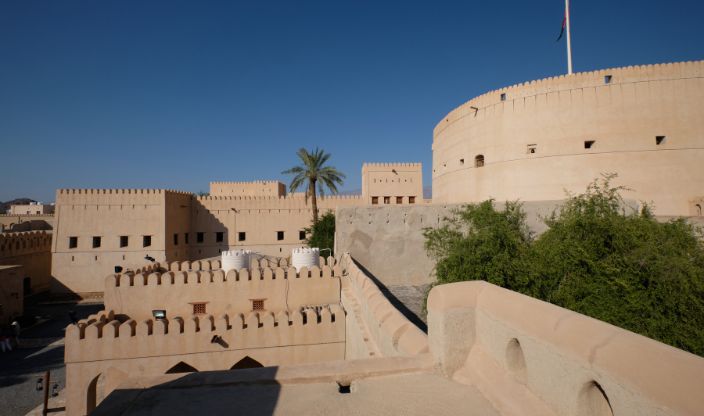Introducing Oman
An Arabian experience like no other, Oman has endless desert dunes, grand landscapes and landmarks of historic and cultural significance. The barren desert plain that makes up much of Oman is interspersed by towering mountains, vast gorges, and lakes that are crystal clear. Embark on your Oman holiday in Muscat, the country’s capital and a place known for its world-class souks and monuments. Visit the beaches of Ras al Hadd and Ras al Jinz to observe turtles coming ashore to lay their eggs. After exploring the beauty of its cities and historic attractions, take the ride of your life in a 4×4 to absorb the impressive landscape of its desert dunes and scenic vistas.
Oman is a country in the Middle East and is surrounded by Saudi Arabia, the United Arab Emirates, and Yemen to the west, the Arabian Sea to the southeast, and the Gulf of Oman to the north. Oman covers a total area of around 119,500 square miles. Oman, the 70th largest country in the world, has a greater population concentration in its cities than in its rural areas. The country’s large cities are home to roughly 73% of the population, while Oman’s rural areas are home to the remaining 27%.
Between October and April, when temperatures are warm to hot (17°C to 35°C), is the ideal season to visit Oman. If you don’t enjoy the sweltering heat of the summer months between June and August, travelling outside of this time is recommended.
Rain is sporadic and only frequently occurs in January and February as brief, intense showers.
Salalah, located on the southern coast, has a totally different weather system, because it experiences a monsoon season known as khareef. The damp winds of the khareef, which blow from June to September, produce a thick fog that covers the mountains in moisture and gives rise to lush green landscapes. This creates the perfect environment for Salalah’s abundant tropical fruit, which is in season all year long.
Indian, Indonesian, Arab, and East African flavours are part of the gastronomy of Oman. The use of different marinades and spices by Omani cooks creates delicious meals. While many different herbs, spices, onions, garlic, and citrus fruits are used abundantly, unlike other Arabic dishes, Omani food is not particularly spicy. The major ingredients are typically rice with chicken, mutton, or fish. In Oman, the main meal is typically consumed at noon, followed by a small dinner. Key dishes include:
Shuwa: This is a meal that is frequently offered at celebrations. It includes meat that has been marinated with herbs and spices and cooked very slowly in an underground oven, often for as long as two days. This procedure makes the meat incredibly soft.
Maqbous: Saffron is used to give this rice dish its yellow colour. It is prepared and put on top of red or white meat.
Mashuai: This dish includes a whole kingfish that has been cooked over a spit before being combined with lemon rice.
Shows: This is a lamb meal that is prepared with banana and date puree and baked in palm leaves for two days.
The Sumerians of ancient Iraq noted Oman as a significant supply of copper as early as 2,300 BC. Oman was also a source of frankincense. The Persian Empire, which had its headquarters in what is now Iran, ruled Oman around 500 BC.
Islam was embraced by the inhabitants of Oman in the seventh century and Iranian influence terminated at that point. The Portuguese sailed into Oman in 1507 and the country was under their rule for almost 150 years. However, the Omanis drove the Portuguese out in 1650 with Oman and England signing a trading agreement in 1646. The Persians returned by attacking Oman in 1737 but were eventually defeated by Omanis in 1747. Oman has been an independent nation since 1920 by the treaty of Saeeb.
There’s a host of family friendly activities in Oman to enjoy. Some of these include:
Ras al Jinz nature reserve: Experience the green turtles nesting on the same beach they were born in at the Ras al Jinz nature reserve, which is three hours from Muscat.
Visit Wadi Shab, a remote natural pool in Al Sharqiyah, which is only 90 minutes away from Muscat, to dip your toes into the refreshing, clear waters on a hot summer’s day. It’s a great place to also enjoy a picnic.
Head into the desert of Oman to discover the impressive sand dunes either through a fun camel ride or an adrenaline pumping 4×4 jeep ride.
Recommended Oman Specialists
Recommended Experiences in Oman
Top Locations in Oman







